Kenneth L. Gentry Jr.'s Blog, page 105
October 28, 2015
MILLENNIUM IN ESCHATOLOGICAL CHRONOLOGY
 PMT 2015-129 by Kenneth L. Gentry, Jr.
PMT 2015-129 by Kenneth L. Gentry, Jr.
In developing a systematic eschatology we may sort out the standard evangelical viewpoints along millennial lines (though the actual question of the millennium in Rev 20 really should not be central to the discussion). In attaching prefixes to the term “millennium” we modify the second coming of Christ in terms of its connection to the millennium: amillennial, premillennial, and postmillennial. The three basic positions may be briefly defined in terms of their chronology as follows:
Amillennialism: The privative a in “amillennialism” emphasizes that there will be no earthly millennial kingdom as such. As amillennialist George Murray puts it: “amillennial, a term which indicates a denial of any future millennium of one thousand years’ duration.”
Premillennialism: The prefix pre indicates that eschatological system that expects a literal earthly millennial kingdom which Christ introduces by his second coming before (pre) it. This kingdom will transpire on earth under Christ’s direct rule.
The Climax of the Book of Revelation (Rev 19-22)
Six lectures on six DVDs that introduce Revelation as a whole, then focuses on its glorious conclusion. Provides an important, lengthy Introduction to Revelation also.
See more study materials at: www.KennethGentry.com
Postmillennialism: The prefix post points out a lengthy (though not necessarily a literal thousand year long) earthly period in which Christ’s kingdom influences the world, which period will conclude at Christ’s second advent. Puritan era postmillennialism tended to expect a literal thousand-year millennium introduced by the conversion of the Jews (rather than the return of Christ) as the last stage of Christ’s earthly kingdom. Modern postmillennialism tends to see the thousand years as a symbolic figure covering the entirety of the Christian era.
An important sub-class of premillennialism arose in the 1830s. We know it as “dispensationalism.” Generally dispensationalists often attempt to link the two different systems, to beef up their historical argument. But we must understand that historic premillennialists strongly disavow any commonality with dispensationalism. Premillennialist George E. Ladd vigorously protests the equation of dispensationalism and historic premillennialism. He even calls any equating of the two a “mistake.” This explains why the popular book edited by Robert G. Clouse is titled The Meaning of the Millennium: Four Views. Anthony A. Hoekema notes that “divergent interpretations of [Revelation 20] have led to the formation of at least four major views about the nature of the millennium or the millennial reign here described.” Many other evangelicals recognize four basic positions, including for instance amillennialists Grenz and Riddlebarger, as well as premillennialist Grudem.
Blomberg and Chung design their recent important historic premillennial work for the express purpose of distinguishing premillennialism and dispensationalism: A Case for Historic Premillennialism: An Alternative to “Left Behind Eschatology (2009). In that work we note the following strong distancing: The two systems “are two very different kinds of movements,” “two versions of futurist premillennialism,” which involve “fierce divisions.” They lament that “Ladd paid a price for his [premillennial] views; for the next three decades, he told his Fuller students about the recriminations and condemnations sent his way by angry dispensationalists.” In fact, “Conservative Baptist Theological Seminary also paid a price” for allowing “various premillennialist views, which produced intense outside opposition for decades.” They speak of “the differences between dispensational and nondispensational premillennialism and the intense concern of their respective adherents that they not be confused.”
Classic dispensationalists are aware of their own distinctive differences, as well. Ryrie even comments: “Perhaps the issue of premillennialism is determinative [for dispensationalism]. Again the answer is negative, for there are those who are premillennial who definitely are not dispensational. The covenant premillennialist holds to the concept of the covenant of grace and the central soteriological purpose of God. He retains the idea of the millennial kingdom, though he finds little support for it in the Old Testament prophecies since he generally assigns them to the church. The kingdom in his view is markedly different from that which is taught by dispensationalists since it loses much of its Jewish character due to the slighting of the Old Testament promises concerning the kingdom.” Ryrie even argues for “The Necessity of Dispensationalism” over against premillennialism.
God Gave Wine (by Ken Gentry)
A biblical defense of moderate alcohol consumption. Considers all key biblical passages and engages the leading objections.
See more study materials at: www.KennethGentry.com
Allis offers us a helpful eschatological sorting device, which Adams modifies. It works quite well in classifying the three basic millennial positions. Two questions tend to sort the positions into one of the three most basic schools. These questions are:
(1) What is the chronology of the kingdom?
(2) What is the nature of the kingdom?
The chronological question focuses on the timing of Christ’s second advent in relation to the kingdom’s establishment. If his coming is before the kingdom, then the position is premillennial; if it is after the kingdom, then it may be either amillennial or postmillennial. The question regarding the nature of Christ’s kingdom highlights its historical character. If the kingdom will have a radical, objective, transforming influence in human culture, it is either premillennial or postmillennial; if it will not, it is amillennial.








October 26, 2015
THEONOMY AND ACTS 25
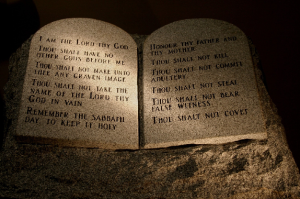 PMT 2015-128 Kenneth L. Gentry, Jr., Th.D.
PMT 2015-128 Kenneth L. Gentry, Jr., Th.D.
Theonomy is not an essential element of postmillennialism. Many postmillennialists are even opposed to theonomy. But it is a component of the form of postmillennialism that I have adopted. And it fits well with the outlook for future ethical conduct rooted in God’s word.
But some scholars point to Acts 25:11 as biblical evidence against the theonomic thesis.
“For if I am an offender, or have committed anything worthy of death, I do not object to dying; but if there is nothing in these things of which these men accuse me, no one can deliver me to them. I appeal to Caesar.” Acts 25:11
The Anti-theonomic Charge
In Will Barker’s Theonomy: A Reformed Critique, Dennis Johnson, of Westminster Theological Seminary, attempts to disprove theonomy, partly be reference to this verse. His comments on this verse are:
Is Paul here making a direct appeal to the Mosaic judicial laws as defining crimes that cause one to be `deserving of death’? Certainly Paul does claim not to have violated the law of the Jews (v. 8), but it is pressing his words further than the context will allow to argue that Paul expects the pagan Festus to understand the complexities of the Torah . . . well enough to find Paul’s appeal intelligible and persuasive. On this point it is most natural to suppose that Paul is appealing to Roman law (pp. 180-81).
Johnson has seriously erred here. There are numerous and compelling indications that the Mosaic sanctions are in Paul’s mind as he utters the words of Acts 25:11.
Christian Theistic Ethics
29 Gentry class lectures on mp3 USB
Formal Christ College course on Christian Theistic Ethics. Demonstrates theonomic underpinnings of Christian ethics. Helpful for learning the theonomic system of ethical thought.
See more study materials at: www.KennethGentry.com
The Theonomic Response
First, though Paul himself is in Caesarea, this portion of his series of trials was initially engaged before the Sanhedrim and Festus by Jews in Jerusalem (Acts 25:1-2). These accusers demanded that Paul be brought to Jerusalem for trial (v. 3). Thus, its historical circumstances were pre-eminently in terms of Jewish legal concerns.
Second, according to J. A. Alexander’s comments on Acts 25:7, “the nature of these charges may be gathered from the former accusation [Acts 24:5-6] and the abstract of Paul’s answer in the next verse.” The “former accusation” is found in Acts 24:5-6, where the charges before Felix read: “For we have found this man a plague, a creator of dissension among all the Jews throughout the world, and a ringleader of the sect of the Nazarenes. He even tried to profane the temple, and we seized him, and wanted to judge him according to our law.” Indisputably these are Jewish charges that, in the Sanhedrim view, demand redress “according to our law.”
The “abstract of Paul’s answer” is found in verse 8: “Neither against the law of the Jews, nor against the temple, nor against Caesar have I offended in anything at all.” The first two foundational points of defense relate to “the law of the Jews” and the charge regarding temple desecration. And then he adds for good measure that he has not even offended Caesar’s law.
Third, because of this, Festus asked Paul: “Are you willing to go up to Jerusalem and there be judged before me concerning these things?” (Acts 25:9). The case is close to being remanded back to the Sanhedrim, where matters of Jewish law would be dealt with.
Fourth, an earlier charge in this series of legal woes for Paul directly relates his worthiness of death to the Jewish law: “I found out that he was accused concerning questions of their law, but had nothing charged against him worthy of death [axion thanatou] or chains” (Acts 23:29). The same terminology is used by Paul in his protestation against the charges against him: “For if I am an offender, or have committed anything worthy of death [axion thanatou], I do not object to dying” (Acts 25:11a).
It is important to notice that Paul considers the case already to have been tried and concluded in Jerusalem before the Sanhedrin: “. . . but if there is nothing in these things of which these men accuse me, no one can deliver me to them. I appeal to Caesar” (Acts 25:11b). That is, “if such is the result of the investigation just concluded, then I do not refuse. . . .” “These things” charged to Paul are clearly spelled out in Acts 23:28-29: “And when I wanted to know the reason they accused him, I brought him before their council. I found out that he was accused concerning questions of their law, but had nothing charged against him worthy of death or chains.” And later in Acts 24:13 and 20, he confirms that the trial by the council (sunhedrion) could not establish his guilt: “Nor can they prove the things of which they now accuse me. . . . Or else let those who are here themselves say if they found any wrongdoing in me while I stood before the council.” Because of the concluded proceedings Paul can say to Festus: “To the Jews I have done no wrong, as you very well know.”
Fifth, Festus writes King Agrippa regarding Paul, pointing to the Jewish charges that failed to prove him guilty of a capital offense, as they themselves argued: “King Agrippa and all the men who are here present with us, you see this man about whom the whole assembly of the Jews petitioned me, both at Jerusalem and here, crying out that he was not fit to live any longer” (Acts 25:24). His entire trial before the Jewish and Roman authorities reminds us of Christ’s trials, wherein the Jews accused Jesus with religious charges in seeking His death: “We have a law, and according to our law He ought to die, because He made Himself the Son of God” (John 19:7).
Interestingly, in light of Johnson’s complaint against the theonomic reference to this passage, Festus admits that the Jews “had some questions against him about their own religion and about one, Jesus, who had died, whom Paul affirmed to be alive. And because I was uncertain of such questions, I asked whether he was willing to go to Jerusalem and there be judged concerning these matters” (Acts 25:20). In fact, Paul is delighted to appear before Agrippa “especially because you are expert in all customs and questions which have to do with the Jews” (Acts 26:3). He is ready to re-defend himself against “all the things of which I am accused by the Jews” (Acts 26:2).
Acts 25:11 is relevant to the theonomic argument, and in no way a hindrance to it.
Covenantal Theonomy
(by Ken Gentry)
A defense of theonomic ethics against a leading Reformed critic. Engages many of the leading objections to theonomy.
See more study materials at: www.KennethGentry.com








October 23, 2015
KEY ELEMENTS IN A CHRISTIAN WORLDVIEW
 PMT 2015-127 by Kenneth L. Gentry, Jr.
PMT 2015-127 by Kenneth L. Gentry, Jr.
Holding and understanding a worldview is an important function of the Christian faith. And a full worldview involves eschatology. Unfortunately, too few Christians today are familiar with the concept or importance of a Christian worldview.
But what is a worldview? The core concept of a worldview may be expressed in a simple, one-sentence definition:
“A worldview is a conceptual framework through which we understand the world and our life in it.”
We can easily see why this is a little more fully called: a “world-and-life view” in that it provides an organizing outlook on both our own lives as well as the world round about us.
The essential presuppositions undergirding the Christian worldview and its view of history include the following key concepts: God, creation, providence, fall, redemption, revelation, and consummation.
God
A proper view of history, its meaning, and purpose requires a proper view of God. God exists and is absolutely independent and wholly self-sufficient. In Exodus 3:14 he defines himself by his special covenantal name “YHWH” (“Yahweh / Jehovah”). This is his name “forever” (Exo 3:15). It is so prominent that the Scriptures can simply mention “the name” (Lev 24:11, 16). God jealously establishes a fundamental moral law that his name must not be used in vain (Exo 20:7; Deut 5:11). In Exodus 3:14 he identifies himself as: “I am that I am.” This self-designation is peculiarly important to our understanding of God. This name-statement is found in the imperfect tense in Hebrew, thereby emphasizing a constantly manifested quality.
From this name we may discern certain of God’s intrinsic qualities: (1) His self-sufficiency: God exists of himself. He is wholly uncreated and self-existent. There is no principle or fact back of God accounting for his existence: “the Father has life in Himself” (John 5:26; Acts 17:25; cp. Isa 40:20–25). Indeed, “in the beginning God” (Gen1:1a) — for he “created all things” (Eph 3:9). (2) His eternity: he is of unlimited, eternal duration. The combination of the verb tense (imperfect) and its repetition (“I am” / “I am”) emphasize his uninterrupted, continuous existence. Indeed, “from everlasting to everlasting, Thou art God” (Ps 90:2; cp. Ps 93:1–2; Isa 40:28; 57:15).
(3) His sovereignty: he is absolutely self-determinative. He determines whatever he wills from within his own being. He can declare absolutely “I am that I am,” without fear of any overpowering or countervailing entity or force to challenge him. As the Absolute One he operates with unfettered liberty. He is not conditioned by outward circumstance. He is what he is because he is what he is. He is completely self-definitional and has no need of anything outside of himself (Isa 40:9–31), for “I am God, and there is no one like Me” (Exo 9:14; cp. Isa 44:7; Jer 50:44).
(4) His immutability: he declares “I, the LORD, do not change” (Mal 3:6). He is forever the same, for in him “there is no variation, or shifting shadow” (Jms 1:17). Thus, we can trust that he will not change his mind or his plan in governing history, for “God is not a man, / that He should lie, / Nor a son of man, / that He should repent; / Has He said, and will He not do it? / Or had He spoken, and will / He not make it good?” (Num 23:19).
Blame It on the Brain?
Sub-title: Distinguishing Chemical Imbalances, Brain Disorders, and Disobedience
by Edward T. Welch
Depression, Attention Deficit Disorder, Alcoholism, Homosexuality.
Research suggests that more and more behaviors are caused by brain function or dysfunction.
But is it ever legitimate to blame misbehavior on the brain?
How can I know whether my brain made me do it?
See more study materials at: www.KennethGentry.com
Creation
All of reality derives from a personal, moral, sovereign being: the God of Scripture. Scripture powerfully declares that “there is but one God, the Father, from whom are all things and we exist for Him; and one Lord, Jesus Christ, by whom are all things, and we exist through Him” (1 Cor. 8:6). All things, of all sorts, were created by him (John 1:3; Col. 1:16).
The Christian’s creational viewpoint puts man under God and over nature (Gen 1:26–27; Psa 8). It imparts transcendent (higher) meaning to temporal history and sets before man a high calling. The entire universe from the smallest atomic particle to the largest and farthest flung galaxy was created out of nothing. It exists solely by the exercise of God’s creative will, and was brought into being by his sovereign, successive, spoken commands (Gen 1:1; Exo 20:11; Heb 11:3). All facts and laws, all people and materials, trace their origin, meaning, and purpose back to God.
The Christian faith is concerned with the material world, the here and now. The Christian interest in the material here-and-now is evident in that: (1) God created the earth and man’s body as material entities, and all “very good” (Gen 1:1-31; 2:7). (2) The Son of God took upon himself a true, material human body in order to redeem man (Rom 1:3; 9:5; 1 John 4:1-3). (3) God’s word directs us how to live in the present, material world (Rom 12:1-2; Eph 5:15-17; 2 Tim 3:16-17). (4) God intends for us to remain on the earth for our fleshly sojourn, and does not remove us upon our being saved by his grace (John 17:15; Job 14:5; 2 Cor 5:9-10). Thus, prior to our ultimate destination in the eternal state, we must recognize the truth that all men live before God in the material world (2 Chr 16:9; Psa 33:13-15; Prov 15:3; Acts 17:28; Heb 4:13), which he has created for his own glory, as the place of man’s habitation (Psa 24:1; 115:16; Prov 15:3; Dan 5:23; Acts 25:24-31; Rev 4:11).
Providence
God has an eternally-decreed, sovereignly-determined plan for the Universe. He personally and intimately administers this plan for his own glory. Providence imparts transcendent meaning into the flow and direction of history. God “works all things after the counsel of His will” (Eph 1:11; cf. Psa 33:11; Isa 45:10–11); he “causes all things to work together” (Rom 8:28a). Christ himself is before all things, and by means of him all things hold together or cohere (John 1:1; Col. 1:17). He carries along or upholds all things by the word of his power (Heb. 1:3). Providence in the Christian worldview is the alternative to Chance in the non-Christian worldview.
Fall
Because of God’s testing of Adam, which results in Adam’s Fall (Gen 3:1–8), history becomes the battleground of Christ and Satan (Gen 3:15). Sin affects every aspect of human endeavor, distorting all of reality. We cannot understand our historical situation apart from the intrusion of sin, as an unnatural factor. Neither may we think of man’s fundamental problem as related to his being finite. In fact, finite Adam’s pre-Fall abilities were remarkable (Gen 2:15, 19–20), as will be our resurrected existence (1 Cor 15:42–53). Rather man’s fundamental problem is ethical, related to his rebellion against God and his Law-word (Gen 3:1–7; Rom 1:18–23; 5:10; 8:7–8). Because of this he labors under God’s curse (Gen 3:14–15; Rom 5:12–19; Gal 3:10).
But God does not abandon history because of man’s Fall. Instead, history witnesses the rising of a new factor to compensate for the fall: redemption.
Political Christianity (book)
(by Christian Citizen)
Christian principles appliend to practical political issues, including “lesser-of-evils” voting.
See more study materials at: www.KennethGentry.com
Redemption
A major force in history is God’s redemptive activity in reconciling creation back to himself (Gen 3:15; Col 1:19–23). God establishes his redemptive plan in order to bring wayward man back to himself. “God did not send the Son into the world to judge the world, but that the world should be saved through Him” (John 3:17). In fact, “the Son of God appeared for this purpose, to destroy the works of the devil” (1 John 3:8). We can possess no proper understanding of historical progress and political hope when referring only to the Fall of man. We must take into account also God’s restorative acts in redemption.
Revelation
God reveals himself and various aspects of his will infallibly and inerrantly in his holy word, the Bible: “All Scripture is inspired by God . . . so that the man of God may be adequate, equipped for every good work” (2 Tim 3:16; cp. John 10:35; 2 Pet 1:20, 21). God’s causative, creative word is also his providential, governing word. God’s eternal decree, from which his prophetic word springs into history, is neither abstract nor random; it is concrete and rational. It is not raw, brute force, but wise, structured power. God’s word intelligibly constructs all things, “declaring the end from the beginning” (Isa 46:10; cp. Psa 33:11; 148:5; Heb 1:3; 11:3). God’s objective revelation in Scripture is foundational to a truly Christian political hope.
Consummation
Not only does history have a beginning, not only does God providentially guide it, but he does so toward a particular end: “He has fixed a day in which He will judge the world in righteousness” (Acts 17:31; cp. Isa 46:10; 55:11). Our labor on earth “is not in vain in the Lord” (1 Cor 15:58). We labor in the present with a view to the future — and ultimately to history’s consummation and the eternal state. “For our citizenship is in heaven, from which also we eagerly wait for a Savior, the Lord Jesus Christ; who will transform the body of our humble state into conformity with the body of his glory, by the exertion of the power that He has even to subject all things to Himself” (Phil 3:20–21). We labor in the light of God’s victory, not in the darkness of the unknown.









October 21, 2015
LUKE 17 VERSUS MATT 24
 PMT 2015-126 by Kenneth L. Gentry, Jr.
PMT 2015-126 by Kenneth L. Gentry, Jr.
As I argue in several places in my writings, Matthew 24 is answering two questions from the disciples. They assume the destruction of the temple means the destruction of the world (Matt 24:1–3). But Jesus separates the destruction of the temple from the second coming and the end of history. We see him drawing a line between the two events between verses 34 and 36 in Matt 24.
Some see a problem with this due to Luke 17. They argue that because of Luke 17 Matthew 24 in its entirety must be focusing on AD 70. This is because Luke 17 seems to mix up the material that we claim is so well-structured and sorted in Matthew 24. And if this is so, then we no longer have any warrant for separating the two events.
In response I would note the following.
First, this issue is not really a crucial matter
Orthodox preterists see no doctrinal problems arising if we apply all of Matthew 24 to AD 70. We generally do not do so because of certain exegetical markers in the text. But if these are not sufficient to distinguish the latter part of Matthew 24 from the earlier part, it would not matter.
Olivet Discourse Made Easy
by Ken Gentry
Verse-by-verse analysis of Christ’s teaching on Jerusalem’s destruction in Matt 24
See more study materials at: www.KennethGentry.com
As I argue in PMT 2014-053 thru 054, however, I do believe we should recognize a transition in Matthew 24:34–36. That being so, how do we explain the problem of Luke’s “mixing up” the Matthew 24 material? This leads to my second point.
Second, the two texts record different sermons
The Lord presents the discourse recorded in Matthew 24 on the Mount of Olives (Mt 24:3) after looking out over Jerusalem (Mt 23:37). Whereas in Luke 17 he is on his way to Jerusalem (cf. Lk 17:11; 18:31; 19:11). In Matthew Jesus is answering his disciples regarding their question about the temple’s future (Mt 24:1–3). In Luke 17 he is interacting with the Pharisees (Lk 17:20–23) about the coming of the kingdom, when he turns to speak to the disci-ples. No one is commenting on the temple, as in Matthew 24:1–2. In fact, we find Luke’s version of the Olivet Discourse four chapters later in Luke 21:5–24.
As Morris notes regarding liberals who argue that Luke places this teaching in the wrong context: “It is much better to hold that . . . Jesus [either] uttered the words on more than one occasion or . . . Luke is correctly applying them to another situation” ( Morris, Acts, 286). So no matter what Jesus is speaking about, Luke is not shifting the material around. He is recording a different sermon altogether.
Third, similarity does not entail identity
That is, because similar prophecies occur in Matthew 24 as in Luke 17 does not mean they apply to the same events. We see that similar expressions do not require identical realities when Scripture refers to Christ as a “lion” in some places (Rev 5:5), whereas in other places it calls Satan a “lion” (1Pe 5:8). Consider the prophetic concept of “the day of the Lord.” As I point out on pages 341–43 above, in the Old Testament it occurs in several places and applies to different historical judgments. For instance, the day of the Lord comes upon Babylon, Idumea, and Judah (Isa 13:6, 9; Eze 13:5; Joel 1:15; 2:1, 11; Am 5:18, 20; Ob 15; Zep 1:7; Mal 4:5). Even though the language is the same (after all, all wars are basically similar) and the phrase occurs in the singular (which suggests there is only one day of the Lord), these must be different events.
Fourth, Jesus is employing stereotypical language
By that I mean that some images can apply to different events. For instance, Sodom frequently represents man’s rebellion deserving God’s judgment — even when not referring expressly to Sodom itself (Dt 29:23; Isa 1:9–10; 3:9; 13:19; Jer 23:14; 49:18; 50:40; Lam 4:6; Am 4:11). Notice Jesus’ own reference to Lot from the Sodom episode (Lk 17:28–29, 32) and to Noah’s flood (Lk 17:27; Mt 24:37–38). The flood in Noah’s day becomes an image of God’s judgment in other contexts (Isa 54:9; Eze 14:14, 20; Heb 11:17; 1Pe 3:20; 2Pe 2:5).
Likewise, Old Testament judgment language is often stereotyped, so that it can apply to different historical episodes. For instance, in the historically distinct judgments upon Babylon, Edom, and Egypt we read of the stars and moon being darkened or wasting away (Isa 13:1, 10; 34:4–5; Eze 32:2, 7–8). Using the hyper-preterist approach we should argue that these are the same events because of the same language. But instead, scholars recognize the common use of stereotypes in prophecy.
Fifth, Jesus is merely pointing out common life issues.
In both chapters that we are considering, Jesus uses mundane activities as cameos of every day life. These are not alluding to historically datable events. Consider, for instance, Christ’s references to the two men in the field (Lk 17:36; Mt 24:40) or the two women grinding at a mill (Lk 17:35; Mt 24:41). These are portraits of daily life activities that will be caught up in and overwhelmed by God’s judgment. Thus, these serve as compelling images of the disruption of daily life cycles, as in Exodus 11:5; Job 31:10; Isa 47:1–2.
Great Tribulation: Past or Future? (Thomas Ice v. Ken Gentry)
Debate book on the nature and timing of the great tribulation
See more study materials at: www.KennethGentry.com
Sixth, the record of the temple cleansing exposes the interpretive error.
Using the hyper-preterist’s method of noting inter-linking language as evidence that the same events are in view is mistaken. For if you use this method you will conclude that the Gospels are in error in assigning a temple cleansing to the beginning of Christ’s ministry (Jn 2:13–17) as well as one to its end (Mt 21:12–13). The language is so similar that liberals say that one of the Gospels must be making a mistake by putting it in the wrong historical context. Yet the integrity of the Gospel record demands that Christ did this twice.
Consequently, exegetical integrity does not require that the latter portion of Matthew 24 reflects the same event as the earlier portion.








October 19, 2015
REVELATION’S JUDAIC IMAGES
PMT 2015-125 by Kenneth L. Gentry, Jr.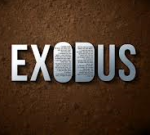
This is the final study in a four-part series demonstrating Revelation’s extremely Judaic character. This peculiar characteristic underscores John’s theme of God’s judgment on Israel in AD 70.
John’s style is such that “the reader unfamiliar with the OT is hard pressed to make any sense of Revelation” (Beale and Carson). This is because “when reading the book of Revelation one is plunged fully into the atmosphere of the Old Testament. No book of the New Testament is as saturated with the Old as is the Apocalypse” (McKelvey).
Beale and Carson, in fact, that “the imagery is drawn almost exclusively from the OT” so that Rev presents an “overall Semitic style” (Beale). Below I will note in detail the presentation by Fekkes that lists a larger number OT persons, institutions, and geographical features found in Rev, including Balaam, David, Moses, Gog and Magog, the altar of sacrifice, the ark of the covenant, and the tabernacle. As Prigent observes “the ideological context of the book of Revelation is essentially the OT.” Once again, these are most appropriate for a work dealing with the historical failure of Israel and God’s coming judgment on her.
Before Jerusalem Fell
(by Ken Gentry)
Doctoral dissertation defending a pre-AD 70 date for Revelation’s writing. Thoroughly covers internal evidence from Revelation, external evidence from history, and objections to the early date by scholars.
See more study materials at: www.KennethGentry.com
A widely-noted, recurring theme in Rev is the OT exodus motif which was “the foundational event in Israel’s history” and even “became permanently definitive of the nature of Yahweh, Israel’s God” (Wright). It was central to Israel’s history (Ex 20:2–3; Dt 5:6–7), celebrated at its occurrence (Ex 15:1–18), and mentioned repeatedly elsewhere in song (Pss 78; 105; 106) and prophecy (Eze 20:3–26; Isa 40:3–5; Am 4:10). Some note that since exodus was written, “confessions of faith from this point on derive from the exodus events” (Baker’s Evangelical Dictionary of Biblical Theology).
Thus “the motif of the exodus is one of the unifying images of the Bible. The literal exodus of Israel from Egypt . . . becomes the single richest source of allusion for OT writers” (Dictionary of Biblical Imagery). Imagery reflecting the exodus and the conquering of the Promised Land even fires the imagination of first-century Jewish anti-establishment enthusiasts. For instance, Theudas threatens to encircle Jerusalem and to cause the walls to collapse at his command (J.W. 2:13:5 §261; Ant. 20:8:6 §169; Ac 21:38), just as Joshua does at Jericho (Jos 6).
Stephen even employs exodus imagery in his polemic against Israel’s rulers (Ac 7:39–43). In fact, in Rev “a good case can be made for the dominance of the Sinai story (including the plague sequence)” (Moyise). Mathewson lists the following verses reflecting exodus imagery just from Second Isaiah: Isa 40:3–5; 41:17–20; 42:14–16; 43:13, 14–21; 48:20–21; 49:8–12; 51:9–10; 52:11–12; 55:12–13. Bauckham explains that “since the exodus was the key salvation event of the history of Israel, in which God liberated his people from oppression in Egypt, destroyed their oppressors, made them his own people and led them to theocratic independence in a land of their own, it was naturally the model for prophetic and apocalyptic hopes of another great salvation even in the future.”
In Rev we see exodus imagery in many places, such as: Jesus as the Passover Lamb (5:6–10; 7:14; 12:11; 13:8; cp. Ex 12:12, 23), ransomed / purchased people (5:9; 14:3–4; cp. Dt 7:8; 13:5), sealing of the faithful (Rev 7:4–7; cp. Ex 12:7, 22–23), plagues (8:7ff; 15:1ff; cp. Ex 7–11), deliverance on eagle’s wings to the desert (12:14; cp. Ex 19:4; Dt 32:11), the “song of Moses” (15:3–4; cp. Ex 15), lightning, earthquake, and trumpet sound (8:2, 6ff; 16:18; cp. Ex 19:16–18), kingdom of priests (1:6; 5:10; cp. Ex 19:5–6), one of the two witnesses modeled on Moses (11:6), the city called “Egypt” (11:8), the ark of the covenant (11:18; cp. Ex 25:10ff), the drying up of the sea (Rev 21:1c; cp. Ex 14:16, 21–22), and more.
Homosexual Question
(5 mp3s sermons by Ken Gentry)
The homosexual movement is one of the leading challenges to the moral stability of
American culture and to our Christian influence in culture.
In this sermon series Dr. Gentry tackles the homosexual question head on
See more study materials at: www.KennethGentry.com
Beasley-Murray notes regarding the “exodus typology” in Rev that “the parallel to the exodus narrative in the Old Testament is not accidental but conscious and deliberate.” Beagley shows how this fits our pre-70 context and Jewish judgment concerns, noting that he: “investigated the use of the Exodus motif in the Apocalypse, and the conclusion was reached that this motif constitutes the overall theological framework in which the Seer presents his message. . . . The Christian community is depicted as the counterpart of the Israelites who were preserved from judgment, while the Egyptians themselves suffered fearful torments. Jesus Christ is presented as the Passover Lamb. But who or what in Revelation is the counterpart of Egypt, on whom the judgments fell? . . . The author himself provides his readers with a clue: there is one explicit mention of the name ‘Egypt,’ and it is applied to ‘the great city . . . where their Lord was crucified’ (11:8). . . . We thus have prima facie evidence that the plagues of Revelation are to fall upon Jerusalem.”








October 16, 2015
SPEAKING IDOL AND JEWISH TEMPLE
PMT 2015-124 by Kenneth L. Gentry, Jr.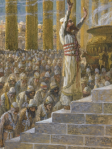
Here in Rev the temple speaks as an image of the emperor-god. When the Pharisees rebuke Christ for not stopping those who praise him at the triumphal entry, “He answered and said, ‘I tell you, if these become silent, the stones will cry out!’” (Lk 19:40). This probably signifies that the stones of the temple will declare him when not one is left on another in AD 70 (cp. Lk 21:5-6) (See: R. C. H. Lenski, Luke, 966; E. E. Ellis, Luke [NCBC], 226). Prosopopoiia clearly appears as a major feature in the later chapters in Rev where two cities are presented as women, one an evil harlot, the other a righteous bride (Rev 17; 21).
Beckwith (Apocalypse, 680) surmises that the altar speaking in 16:7 really represents the voices of the souls at the altar (6:9) or the prayers of the saints at the heavenly altar (8:3-5). If this is preferred, then the image speaking (which represents the physical temple speaking) would indicate decrees from the temple authorities. It could suggest either the deceptive liturgy of the temple that keeps the Land-dwellers under control or the death decrees sent out from it against “apostate” Christians.
Pushing the Antithesis (by Ken Gentry)
Sub-title: The Apologetic Methodology of Greg L. Bahnsen
See more study materials at: www.KennethGentry.com
On many occasions the Lord rejects his own worship forms when the people are in sin. “So when you spread out your hands in prayer, / I will hide My eyes from you, / Yes, even though you multiply prayers, / I will not listen” (Isa 1:15). Israel must “not trust in deceptive words, saying, ‘This is the temple of the Lord, the temple of the Lord, the temple of the Lord’” (Jer 7:4). In fact, Jeremiah repeatedly denounces lies and deception from false prophets at the first temple’s destruction (Jer 14:14; 23:21; 27:14-15; 28:15; 29:8). In the face of unbelief and abuse, the temple liturgy becomes a statement offering false comfort — even the well-known, God-inspired Aaronic benediction: “The Lord bless you, and keep you; / The Lord make His face shine on you, / And be gracious to you; / The Lord lift up His countenance on you, / And give you peace” (Nu 6:24-26).
We know that the temple authorities give orders that Jesus be seized (Jn 11:47, 53, 57; 18:3, 12–14). These religious leaders seek his death in order to protect their own positions (Jn 11:48, 53; cp. Jn 5:18; 7:1, 19; Mt 17:23; 26:4// ). And after his death they command the apostles to quit preaching Christ or suffer flogging or death (Ac 4:1-3, 5-7, 17-21; 5:17-18, 21, 25-28, 33, 40; 9:2; 22:5; cp. 28:21). And floggings (Mt 10:17-18; 2Co 11:23) are official actions of a court (Dt 25:2; m. Mid. 2:2; m. Moe’ed Qat. 3:1-2), not mob actions. While the temple stands with its religious rulers it has the power to destructively “speak” against the Lamb and his followers.
Those who do not follow the temple authorities, separate from the temple, and cease the (now) empty liturgy must face the land beast who will “cause as many as do not worship the image of the beast to be killed” (13:15b). This refers to the Jewish followers of the Lamb. According to John in his Gospel, Jesus warns his first disciples that “they will make you outcasts from the synagogue, but an hour is coming for everyone who kills you to think that he is offering service [latreia] to God” (Jn 16:2). The word “service” (latreia) is employed “in cultic usage” (BAGD 586) as in temple ministrations. In fact, the verb form occurs “only of the carrying out of religious duties, esp. of a cultic nature” (BAGD 587).
Christ’s statement implies that killing a disciple of his is used “in the sense of offering a sacrifice” (EDNT 2:344, 345). Carson (1991: 531) points out the following as “evidence that some rabbinic authorities held that slaying heretics could be an act of divine worship”: Num. Rab. 21:3 (191a) and Sanh. 9:6.
Secret Thoughts of an Unlikely Convert (by Rosaria Butterfield)
Remarkable testimony of a lesbian professor who was a leading spokesperson
for the feminist movement, but whom Christ saved.
See more study materials at: www.KennethGentry.com
E. Corsini (The Apocalypse, 1983: 252) explains that: “the allegory of the statue which speaks and issues sentences of death at the wicked suggestions of corrupt religious authorities which stands at its shoulders (13:15), it is not difficult to see the complex intrigue which grew between the High Priest and the Roman authorities which led to the death of Jesus. John sees this as happening daily in his own situation. . . . In fact, as Jesus himself recalls (Matt 23:29ff), the prophets and those sent by God were stoned and slain always with the direct or indirect approval of Jewish religious authority.”








October 15, 2015
ISAIAH, JESUS, AND GRADUAL VICTORY
PMT 2015-123 by Kenneth L. Gentry, Jr.
 In this article I am continuing a response to a reader who wonders if the NT teaches a gradualistic development of Christ’s kingdom to victory. He was especially curious since Rom 8 appears to speak of the fulfillment of Isa 11, with Rom 8 speaking of the consummation rather than history. I recommend reading my previous article to get his particular question before you.
In this article I am continuing a response to a reader who wonders if the NT teaches a gradualistic development of Christ’s kingdom to victory. He was especially curious since Rom 8 appears to speak of the fulfillment of Isa 11, with Rom 8 speaking of the consummation rather than history. I recommend reading my previous article to get his particular question before you.
Postmillennial gradualism and the final order
Postmillennialists not only believe in a large measure of historical victory for Christ’s kingdom but also that we are to expect a final, absolutely perfect order in eternity. We do believe that the whole creation is now groaning under the weight of sin which shows its effect in bodily weakness (Rom 8:22–23). We also believe that even at the very height of kingdom victory before Christ returns and history ends, sin will remain. Even when Christianity has gained ascendency, all will not be perfect, there will still be aging, dying, and groaning. Because there still will be sin. Death is the last enemy; it will be finally defeated in fulness at Christ’s return (1 Cor 15:26, 42–58). See my chapter in: Kenneth Gentry, ed., Thine Is the Kingdom: The Postmillennial Hope.
In addition, we argue that the historical advance of the postmillennial kingdom points to final consummate glory. And this finds an analogy in our own personal experience. We each long for full sanctification in the eternal state, even while we are growing in sanctification here on the earth. Our current gradual growth in grace is a pointer to our final, full sanctification in eternity. Likewise, the kingdom’s growth upon the earth develops the glory-principle on earth even as it looks forward to the full fruit of that glory beyond this fallen realm.
He Shall Have Dominion (by Ken Gentry)
A classic, thorough explanation and defense of postmillennialism (600 pages)
Buy two of these and be the envy of your neighborhood!
Theologians have discerned the Now / Not Yet principle in biblical theology. That is, they recognize that since the first coming of Christ to establish the new covenant, the eternal order exists in seed form even now in history. We can see this in two clear examples from the NT. Just as we long for a future bodily resurrection (John 5:28–29), even now we are spiritually resurrected in Christ (John 5:24–25; Eph 2:6). Even as we long for the consummate, perfected new creation (2 Pet 3:13), we are now a spiritual new creation growing toward that end (2 Cor 6:17; Gal 6:15).
Thus, we enjoy the “Now” even as we long for its fuller expression in the “Not Yet.” The Now / Not Yet principle fits perfectly in postmillennial theology regarding the kingdom.
But now, where in the NT do we find any mention of historical victory for the gospel by means of gradualistic development? My inquirer asks: “apart from 1 Corinthians 15 (‘and he must reign…’) and The Parable of the Mustard Seed and leaven in the lump, I see very little in the New Testament itself which seems to envision the slow growth of the kingdom resulting in a victorious display within an historic millennium.”
Postmillennial gradualism in the NT
Let me respond to the reader’s concern by offering the following:
First, to ask the question in this way effectively answers the underlying concern, which is: Is the teaching of gradualistic kingdom victory biblical? By that I mean, the questioner opens with an admission that gradual victory is, in fact, taught in Scripture, at least in 1 Corinthians 15 and in the Parable of the Mustard Seed. If it is taught in those places by Christ and by Paul, then it is manifestly biblical.
Second, attached to the Parable of the Mustard Seed is its twin parable, the Parable of the Leaven (Matt 13:31–33). The Mustard Seed to presents the kingdom’s external growth (from small seed to large plant), whereas the Leaven Parable teaches its penetrating power (leaven gradually permeates three bushels). Both of these truths are significant for the postmillennial scheme: the victory will come to dominance, it will come gradually, and it will do so from growth within rather than imposition from without.
Third, contained within this same set of Kingdom Parables is another one that teaches the kingdom’s remarkable growth: the Parable of the Sower and Soils. In this parable, the Sower (Christ) sows seed (the gospel) in the earth with the following result: some seed “fell on the good soil and yielded a crop, some a hundredfold, some sixty, and some thirty” (Matt 13:8).
It is true that this is one of four soils upon which the seeds land, and the other three do not grow well, if at all. Nevertheless, the Sower surely prepared his garden for planting so that most of it involved good soil. Though there are four types of soil this does not mean that three-fourths of the seed fail. Otherwise the Sower would be shown as incompetent. The soil to which he aims his seed surely receives the most seed. And that seed produces remarkably well.
Fourth, Jesus gives still another parable that teaches the same gradualistic truth: the Parable of the Seed. In Mark 4:26-29 we read: “The kingdom of God is like a man who casts seed upon the soil; and he goes to bed at night and gets up by day, and the seed sprouts and grows—how, he himself does not know. The soil produces crops by itself; first the blade, then the head, then the mature grain in the head.” Though this one does not speak of the kingdom’s dominance, it does present its developmental growth. And in Mark 4 this leads into the Mustard Seed Parable (Mark 4:30–32).
Fifth, before his crucifixion Jesus promised his disciples: “Now judgment is upon this world; now the ruler of this world will be cast out. And I, if I am lifted up from the earth, will draw all men to Myself” (John 12:31–32). Here he teaches that Satan is about to lose the power that has kept the nations beyond Israel from turning to God. And as a direct result of that casting out, he says he will be lifted up so that he might “draw all men to Myself.” This surely implies a gradual drawing, not everyone all at once. And it certainly speaks of a dominant influence, an influence that can be expressed as involving “all men.”
Sixth, after his crucifixion he presents to his disciples the Great Commission. In that Commission we have a truly great command that involves a great expectation: a promise and expectation of worldwide victory: “Go therefore and make disciples of all the nations, baptizing them in the name of the Father and the Son and the Holy Spirit, teaching them to observe all that I commanded you” (Matt 28:19–20a).
In that he introduces this command with the bold claim that he has “all authority” both “in heaven and on earth” (Matt 28:18), he certainly has the power to seek a great end. And a great end he does seek, for he commands them to “make disciples of all the nations.” He does not call them simply to be a witness to the nations or just to preach to the nations. But actually to disciple them by baptizing and teaching them. This entails global victory over the nations in that the nations are to be baptized and taught.
And we should note that the Great Commission requires gradualistic development. How can these eleven disciples (Matt 28:16) expect to disciple the whole world suddenly? Besides, he even braces them for the historical long run when he assures them by promising: “lo, I am with you always, even to the end of the age” (Matt 28:20b).
Seventh, besides all of this (and I could provide more, if space allowed), what about the many Old Testament references to the kingdom’s gradual development to victory? I would mention just a few samples. In Dan 2 the stone that destroys the evil statue “becomes a great mountain” (Dan 2:35). In Ezekiel 17:22–24 God promises to establish the kingdom as a small “sprig from the lofty top of the cedar.” Then he will nurture it until it becomes “a stately cedar.” In Ezekiel 47:1–9 redemption flows forth from God’s temple in stages. The waters of life initiate from under the altar, first “to the ankles” (47:3), then to the knees (47:4a), then to the loins (47:4b), then it “was a river that I could not ford” (47:5). As a result: “everything will live where the river goes” (Eze 47:9).
One additional comment
This series opened with a brief analysis of Isa 11 and its reference to the peaceable kingdom. In that glorious prophecy we read: “the wolf will dwell with the lamb, / And the leopard will lie down with the young goat, / And the calf and the young lion and the fatling together; / And a little boy will lead them” (Isa 11:6). These are natural enemies brought to peaceful coexistence. This certainly will be the case in the new heavens and new earth after all sin is removed.
Lord of the Saved (by Ken Gentry)
A critique of easy believism and affirmation of Lordship salvation
We must understand, however, that this too involves a Now / Not Yet operation. After all, Christ’s death effects peace between warring parties where the gospel gains victory. We clearly see this in Paul’s teaching in Eph 2:11–18, where such happens to be his main point:
Therefore remember that formerly you, the Gentiles in the flesh, who are called “Uncircumcision” by the so-called “Circumcision,” which is performed in the flesh by human hands— remember that you were at that time separate from Christ, excluded from the commonwealth of Israel, and strangers to the covenants of promise, having no hope and without God in the world. But now in Christ Jesus you who formerly were far off have been brought near by the blood of Christ. For He Himself is our peace, who made both groups into one and broke down the barrier of the dividing wall, by abolishing in His flesh the enmity, which is the Law of commandments contained in ordinances, so that in Himself He might make the two into one new man, thus establishing peace, and might reconcile them both in one body to God through the cross, by it having put to death the enmity. And he came and preached peace to you who were far away, and peace to those who were near; for through Him we both have our access in one Spirit to the Father.








October 12, 2015
WHY DIDN’T IRENAEUS KNOW WHAT 666 MEANT?
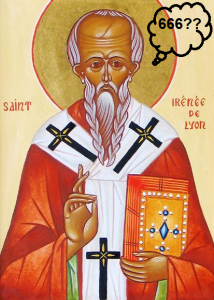 PMT 2014-122 by Kenneth L. Gentry, Jr.
PMT 2014-122 by Kenneth L. Gentry, Jr.
My readers’ questions keep turning to Revelation. I hope I don’t answer them all before my commentary comes out! But here is another one.
Reader’s question:
As I study your argument for 666 as a reference to Nero Caesar, these two questions arise. Could you please explain your understanding of these objections?
If Irenaeus’s statement refers to John rather than the apocalypse, the statement seems to suggest that John wasn’t telling people who the beast was during his lifetime. That seems odd if those things had already occurred.
If John did reveal to his contemporaries the identity of the beast why wouldn’t it have been common knowledge amongst the Christians and therefore Irenaeus?
My response:
Thanks for your questions. In answering both of these questions, I could take recourse to Mark Twain’s experience. He once was asked a question in an interview, regarding which he reported later: “I was glad to be able to answer quickly! I answered: ‘I don’t know.'” When we stop to think about it, there are many questions that arise regarding the history of biblical interpretation. We sometimes are dumbfounded as to how things get lost or turned around. So to the questions you pose, we could respond simply: “I don’t know.”
Ironically though, your first question happens to be exactly what Irenaeus claims: John did not tell who the beast (Antichrist in Irenaeus’ view) was. Irenaeus writes: “We will not, however, incur the risk of pronouncing positively as to the name of Antichrist; for if it were necessary that his name should be distinctly revealed in this present time, it would have been announced by him who beheld the apocalyptic vision. For that was seen no very long time since, but almost in our day.”
Beast of Revelation: Identified (DVD by Ken Gentry)
A biblical and historical argument for Nero being the beast of Revelation. Professionally recorded and edited with Question and Answers session.
See more study materials at: www.KennethGentry.com
Here he says that John did not announce the name of the beast — whenever it was that John lived. And he doesn’t tell us why John did not inform his hearers. If Irenaeus’ report were true, it would account for why we don’t have a clear indication of the identity of the beast in church tradition (which, as a matter of fact, we do not have).
Regarding your second question I usually point out that 666 must have meant something. John certainly emphasizes the number of the beast as indicating the identity of the beast. Whatever it originally meant to John, it somehow was lost early on (much to our regret!). Irenaeus poses three possible options in the preceding context, but then gives the statement cited above. He doesn’t know even though he claims John lived almost into his own lifetime and taught people whom he himself knew.
We know that teachings can be quickly scrambled or lost. Think of how often the Lord told the disciples he must die, only to have them confused and dismayed when he died — even doubting the women who saw him after the resurrection. Some even doubted the resurrection after they saw him with their own eyes (Mt 28:17). Think of how quickly the Galatians fell from the truth (Gal 1:8). We wouldn’t have so many denominations and doctrines if things were clearly understood once they had been taught.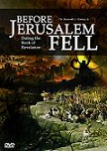
Before Jerusalem Fell Lecture
DVD by Ken Gentry
A summary of the evidence for Revelation’s early date. Helpful, succinct introduction to Revelation’s pre-AD 70 composition.
See more study materials at: www.KennethGentry.com
We can imagine this problem being more apt to happen regarding a complex and symbolic book like Revelation. Apparently John wanted to tantalize his audience in his drama. After all, he could have written it in another form than symbolic drama (for instance, consider his Gospel). There is so much in Revelation that is confusing!
Furthermore, it may well be (and I think is the case) that John died not long after his release from imprisonment on Patmos. In my view, Irenaeus’ statement that indicates John lived almost into Irenaeus’ own lifetime could very well be mistaken. Like his claim (on the same grounds: tradition) that Jesus ministered for 15 years and died when approaching age 50. In other words, he simply was mistaken.
In addition, I suspect that a part of the problem with the loss of the meaning of the name of the beast lies in the circumstances of the church thereafter. As the church was being persecuted over the next couple of centuries, she began to apply the prophecies of Revelation to herself in making them “relevant.” This allowed the original meaning to slip away while offering “encouragement” to those who saw Revelation “being fulfilled” around them. Hal Lindsey is not unique to biblical interpretation; even long ago people thought of Revelation as applying directly to themselves and thought the end of all things was upon them.
I hope this is helpful. You have asked an interesting question that frustrates us.









October 9, 2015
EZEKIEL’S TEMPLE MEASURING
 PMT 2015-121 by Kenneth L. Gentry, Jr.
PMT 2015-121 by Kenneth L. Gentry, Jr.
I appreciate the questions readers send to me. I regret that I am not able to answer them quickly, due to my schedule. However, here is one that is a favorite among dispensationalists. And it is an intriguing one.
Reader’s question:
You argue that John must be measuring an actual, historical temple in Rev 11:1-2. Yet Ezekiel measures a temple, even though it does not exist in history. This suggests that the temple does not need to exist for John to measure it. How do you explain this problem for your view?
My response:
Thanks for your perceptive question. Please consider the following response.
Ezekiel’s prophecy expressly tells us that Israel has been attacked and destroyed. He opens with this statement: “Now it came about in the thirtieth year, on the fifth day of the fourth month, while I was by the river Chebar among the exiles, the heavens were opened and I saw visions of God.” (Ezekiel 1:1.) He is among the exiles because Jerusalem has been attacked and destroyed. Everyone knows that the temple was destroyed in these events.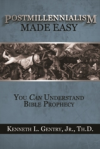
Postmillennialism Made Easy (by Ken Gentry)
Basic introduction to postmillennialism. Presents the essence of the postmillennial argument and answers the leading objections. And all in a succinct, introductory fashion.
See more study materials at: www.KennethGentry.com
Furthermore in Eze 40 where Ezekiel begins the measuring, he opens this vision with: “In the twenty-fifth year of our exile, at the beginning of the year, on the tenth of the month, in the fourteenth year after the city was taken, on that same day the hand of the Lord was upon me and He brought me there” (Ezekiel 40:1). Thus, he introduces the temple vision with words that show the historical temple no longer exists.
Just before this prophecy of the measuring, Ezekiel is promised by God: “Therefore thus says the Lord God, “‘Now I shall restore the fortunes of Jacob, and have mercy on the whole house of Israel; and I shall be jealous for My holy name'” (Ezekiel 39:25).
After he measures the temple, he writes:
“Then he led me to the gate, the gate facing toward the east; and behold, the glory of the God of Israel was coming from the way of the east. And His voice was like the sound of many waters; and the earth shone with His glory. And it was like the appearance of the vision which I saw, like the vision which I saw when He came to destroy the city. And the visions were like the vision which I saw by the river Chebar; and I fell on my face. (Ezekiel 43:1-3)
Thine Is the Kingdom
(ed. by Ken Gentry)
Contributors lay the scriptural foundation for a biblically-based, hope-filled postmillennial eschatology, while showing what it means to be postmillennial in the real world.
See more study materials at: www.KennethGentry.com
And He said to me, “Son of man, this is the place of My throne and the place of the soles of My feet, where I will [future tense] dwell among the sons of Israel forever.” (Ezekiel 43:7a).
Consequently, even a surface reading of Ezekiel repeatedly reminds the reader that the city (and thus the temple) is destroyed and the people exiled. But in Revelation there is no indication that he is having a vision of a future rebuilt temple. The clear implication is that the temple is standing but is in danger.








October 7, 2015
HISTORICISM, REVELATION, AND THE REFORMATION
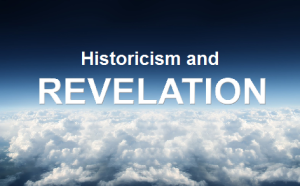 PMT 2015-120 by Kenneth L. Gentry, Jr.
PMT 2015-120 by Kenneth L. Gentry, Jr.
My computer is getting lighter as I remove more of the questions that have been sent to me by readers. Today’s question regarding the Book of Revelation, one of my favorite pastimes!
Reader’s question:
You are committed to the Reformed faith, yet you don’t take the historicist approach to eschatology which was widely held among the Reformers. Why do you not follow the Reformers in this part of their theology.
My response:
Thank you for your inquiry. You are correct that I am committed to Reformed theology. However, I differ from the Reformers in that I take a preterist approach to Revelation rather than an historicist approach. I do so for the following reasons:
First, we should remember that Revelation was not well received among some of the Reformers. Martin Luther, the famed reformer and untiring interpreter of Scripture, originally rejected Revelation as non-canonical, complaining, “My Spirit cannot adapt itself to the book.” In his German translation of the Bible, he complained in the preface to Revelation that the book was “neither apostolic nor prophetic.”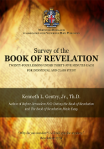
Survey of the Book of Revelation
(DVDs by Ken Gentry)
Twenty-four careful, down-to-earth lectures provide a basic introduction to and survey of the entire Book of Revelation. Professionally produced lectures of 30-35 minutes length.
See more study materials at: www.KennethGentry.com
Fellow reformer Ulrich Zwingli (1484-1531) refused to take a doctrinal proof-text from Revelation. Calvin himself wrote no commentary on it, despite his writing a very thorough series of commentary on almost all of the Bible.
Second, the Reformers were locked in a literal life-and-death struggle with Romanism. Consequently, they tended to view many judgment passages through the lens of their opposition to Rome. They let application override interpretation in some situations.
Such an exposition is known as an “actualizing interpretation.” “Actualizing interpretations take two forms. In one form the imagery of the Apocalypse is juxtaposed with the interpreter’s own circumstances, whether personal or social, so as to allow the images to inform understanding of contemporary persons and events and to serve as a guide for action” (J. Kovacs and C. R. Rowland, Revelation: Apocalypse of Jesus Christ [Oxford: Blackwell, 2004], 9).
For instance, we see this in the original Westminster Confession of Faith (25:6) where the Pope is called the Antichrist and the “man of lawlessness.” This not only gives too much credit to Romanism, but clearly misinterprets Scripture. If the Pope were Antichrist, then the papacy existed in the first century, for John confronts the antichrist in the first century (1Jn 2:18-22). But the Pope cannot be the Antichrist, for John defines the Antichrist as “one who denies the Father and the Son” (1Jn 2:22), as those who “do not acknowledge Jesus Christ as coming in the flesh” (2Jn 7). This is clearly not referring to Roman Catholic teaching.
Third, historicist expositions of Revelation from that era, the 1500-1600s are impossible today. If you can find an historicist exposition of Revelation from you will quickly observe that they believed Revelation outlined church history up to their own time, when they believed its final prophecies were coming to fulfillment. Just reading an earlier historicist exposition today refutes it.
Kovacs and Rowland note this problem: “Altogether more contentious and daring is the way certain interpreters saw these figures appearing in their own day. For some this reflects a conviction that the last days have come” (Kovacs, 128; referenced above). M. E. Boring seems to be correct when he notes that “although widely held by Protestant interpreters after the Reformation and into the twentieth century, no critical New Testament scholar today advocates this view” (M. Eugene Boring, Revelation: Interpretation: A Bible Commentary for Teaching and Preaching [Louisville: John Knox, 1989], 49).
Fourth, by the very nature of the case historicism suffers from a need of constant revision. The historicist school, also called the “continuous historical,” sees the prophetic drama in Revelation as providing a panorama of Church history from the apostolic era to the return of Christ. Historical continuity is the main focus of this approach which forecasts future history. Historicists deem Revelation an “almanac of church history.” Historicists apply the numerous judgment scenes to various wars, revolutions, and socio-political and religious movements (e.g., the rising of Roman Catholicism, the outbreak of the Protestant Reformation, the French Revolution, World Wars I and II), as well as important historical /persons (e.g., various Popes, Charlemagne, Napoleon, Mussolini).
According to Alan Johnson, Joachim of Floris (d. 1202) popularized this view, though traces of it are found earlier in the Ante-Nicene fathers (Johnson, “Revelation” in EBC, 12:409). As noted above, Wycliffe, Luther, Calvin, and the Reformers greatly employed it against the Roman Catholic Church.
Keys to the Book of Revelation
(DVDs by Ken Gentry)
Provides the necessary keys for opening Revelation to a deeper and clearer understanding.
See more study materials at: www.KennethGentry.com
The weaknesses, though, are manifold. The position almost always assumes that present interpreters live at the conclusion to history so that all in Revelation leads up to their time just before the end. For instance Mede noted in his commentary: “While I write news is brought of a Prince from the North (meaning Gustavus Adolphus) gaining victories over the Emperor in defence of the German afflicted Protestants.”
Commenting on recurring problems in eschatological debate in general, Brethren historian F. Roy Coad well states: “Almost invariably interpretation has been vitiated by the reluctance or incapacity of commentators to visualise their own age as other than the end time” (F. Roy Coad, Prophetic Developments: A Christian Brethren Research Fellowship Occasional Paper [Pinner, England: 1966], 10).
As a consequence, beliefs are in a constant state of revision, especially for Revelation commentators in this school. Consequently, as history has grown longer, older varieties of this interpretive school have experienced a great number of failed expectations. This view long remained “strangely attractive in spite of the recurrent anguish and disappointment it causes” (John Court, Myth and History in the Book of Revelation [Atlanta: John Knox, 1979], 7).
Thus, this approach is continually in revision as it proposes more and more constructions based on the supposed prophetic allusions to historic events. For instance, this view was prominent in the Middle Ages when millennialism began to flourish once again. The system was used to show that “the millennium was about to dawn” (Carson, Moo, Morris, Introduction to the New Testament, [Zondervan] 482).
Furthermore, its relevance is confined to the Western world, with the progress of history traced only in a western direction (apparently where book sales are most profitable!).
In addition, it tends to lose its relevance for its original persecuted audience.
Its major problem, though, is that harmony among its proponents is almost wholly lacking due to its subjectivity.









Kenneth L. Gentry Jr.'s Blog
- Kenneth L. Gentry Jr.'s profile
- 85 followers



